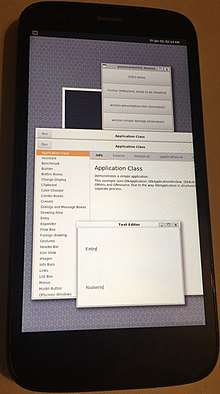postmarketOS
 | |
| Developer | postmarketOS open-source community |
|---|---|
| OS family | Unix-like |
| Working state | Active |
| Source model | Open source |
| Marketing target | Operating system replacement for Android and other mobile devices |
| Update method | apk-tools (package manager) |
| Package manager | apk-tools (from Alpine Linux) |
| Platforms | ARM, ARM64, x86, x86-64 |
| Kernel type | Monolithic (Linux) |
| Official website |
postmarketos |
postmarketOS (abbreviated pmOS) is a free and open-source operating system under development primarily for smartphones, based on the Alpine Linux distribution.[1][2][3][4]
postmarketOS was officially launched on May 6, 2017 with the source code available on GitLab.[2][5] It is capable of running different X and Wayland based user interfaces, such as Plasma Mobile,[6][7] Hildon, LuneOS UI, MATE, GNOME 3 and XFCE.[8] The project aims to provide a ten year lifecycle for smartphones.[9][10]
Architecture
Unlike many other projects porting conventional Linux distributions to Android phones, pmOS does not use the Android build system or userspace. Each phone has only one unique package, and flashable installation images are generated using the pmbootstrap tool.[2] The project intends to support the mainline Linux kernel on all phones in the future, instead of the often outdated Android-specific fork to reduce the potential for security exploits.[2] A few devices can boot into the mainline kernel already.[11][12]
Alpine Linux was chosen as the base distribution due to its low storage requirements, making it more suitable for older devices. Excluding the kernel, a base installation takes up approximately 6 MB.[13][2][14]
State of development
Features
The project is currently under development; and no devices are yet able to make phone calls with postmarketOS[15], although significant efforts are being made in this regard. Different tools have been published by the project, including:
pmbootstrap[16][17], a utility to help the process of development with cross compilation;osk-sdl[18][19], a virtual keyboard to allow decryption of a password during startup (on a device with full disk encryption);charging-sdl[20], a application contained in the initramfs to display an animation when the phone is charging while off.
Device support
As of January 2017, over fifty devices are able to boot the operating system, including 18 with WiFi support.[11] This includes many Android smartphones and tablets,[21][22] wearable devices such as Google Glass, smartwatches including as the LG G Watch and some Linux-based Nokia smartphones, such as the N900[23] and N9.[24][11] The pmOS community continues to add devices, and the progression is documented on the wiki.
Porting to a new device
The development process to make a new device compatible with the operating system consists of creating a phone-specific package using the pmbootstrap tool. For that, the use of the Linux kernel from the device's original manufacturer is often necessary. The source code of the original kernel is often made available by compliance with the requirements of the GPLv2 license, but some drivers necessary for the operation of the device may not be available, and must, therefore, be recreated.[25][16]
Resources for development
The project publishes its code on GitLab,[14][26] and co-ordinates via Matrix and IRC.[27] A wiki is available for documentation of the project.[28][14] The project migrated its source code from GitHub to GitLab following Microsoft's acquisition and due to the proprietary and closed nature of GitHub.[29]
Gallery
 Plasma Mobile on the Nexus 5
Plasma Mobile on the Nexus 5 Hildon on the Nexus 7 (2013)
Hildon on the Nexus 7 (2013)

 LuneOS UI running on a generic x86 tablet
LuneOS UI running on a generic x86 tablet
See also
References
- ↑ Staff, OSNews. "100 days of postmarketOS". www.osnews.com.
- 1 2 3 4 5 "Aiming for a 10 year life-cycle for smartphones". postmarketos.org.
- ↑ "PostMarketOS Saves Old Smartphones". Hackaday. 2018-01-09. Retrieved 2018-01-29.
- ↑ DistroWatch. "DistroWatch.com: Put the fun back into computing. Use Linux, BSD". distrowatch.com.
- ↑ Ward, Craig. "PostmarketOS team makes progress towards goal of 10 year smartphone lifecycle - NotebookCheck.net News". Notebookcheck.net. Retrieved 2018-01-29.
- ↑ "Get Plasma Mobile". plasma-mobile.org.
- ↑ 14:00 Plasma Mobile - Bhushan Shah, Akademy 2017. 20 Nov 2017
- ↑ Verma, Adarsh (2 January 2018). "postmarketOS--A Linux Distro For Smartphones--Now runs Plasma/Lune UI/Xfce On Real Devices".
- ↑ "Linux-based postmarketOS project aims to give smartphones a 10-year lifecycle - Liliputing". 16 August 2017.
- ↑ "Linux-based postmarketOS project aims to give smartphones a 10-year lifecycle". Linux Today. 2017-08-17. Retrieved 2018-01-29.
- 1 2 3 "219 days of postmarketOS". postmarketos.org.
- ↑ Eric Brown (29 September 2017). "New mobile Linux contenders keep the dream alive".
- ↑ "Librem 5 Leads New Wave of Open Source Mobile Linux Contenders | Linux.com | The source for Linux information". Linux.com. 2017-09-29. Retrieved 2018-01-29.
- 1 2 3 "postmarketOS is a Touch-Optimized Linux Distro for Portable Devices". Xda-developers.com. 2017-09-05. Retrieved 2018-01-29.
- ↑ "PostmarketOS can run on older gadgets but with limited features". 5 January 2018.
- 1 2 Chapman, Christian (2017-08-17). "Porting PostmarketOS to the Motorola Photon Q". Public.asu.edu. Retrieved 2018-01-29.
- ↑ pmbootstrap: Sophisticated chroot/build/flash tool to develop and install postmarketOS postmarketOS 2018-01-27 accessed 2018-01-27
- ↑ "Mobile - Debian Wiki". Wiki.debian.org. 2017-12-31. Retrieved 2018-01-29.
- ↑ SDL2 On-screen Keyboard postmarketOS 2017-12-31 accessed 2018-01-27
- ↑ SDL2 charging application for the initramfs postmarketOS 2017-12-23 accessed 2018-01-27
- ↑ "Why Mobile Linux Fails - Datamation". www.datamation.com.
- ↑ Weekly Linux News – January 2, 2018 Lunduke.com
- ↑ "Telefonni revoluce se blizi | OpenAlt 2017 - video zц║znamy a slajdy". Superlectures.com. 2017-11-05. Retrieved 2018-01-29.
- ↑ "Devices - postmarketOS". wiki.postmarketos.org.
- ↑ "Porting to a new device - postmarketOS". wiki.postmarketos.org. Retrieved 2018-01-27.
- ↑ "postmarketOS". GitLab. Retrieved 2018-01-27.
- ↑ "Matrix and IRC - postmarketOS". wiki.postmarketos.org. Retrieved 2018-01-27.
- ↑ "postmarketOS". wiki.postmarketos.org. Retrieved 2018-01-27.
- ↑ "postmarketOS is #movingtogitlab". postmarketos.org. Retrieved 2018-08-02.